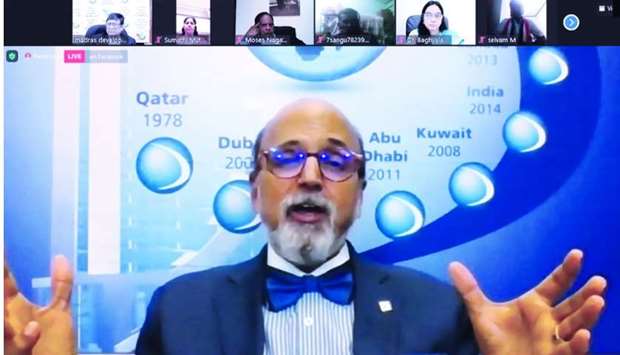Doha Bank CEO Dr R Seetharaman recently spoke about ‘Changing Dynamics and Opportunities Post Covid-19’ during the Virtual Global Economic Summit 2020 organised by World Tamils Economic Foundation, Madras Development Society from December 28 to 30.
“Today, there are 80mn Covid-19 cases globally and it has resulted in lives of more than 1.8mn people. To combat the crisis, central banks across the globe have announced adequate liquidity measures. Central banks have assured sustainability measures in global norms. Globally, approximately $30tn of liquidity is pumped.
“The liquidity has played a role to hold the balance, making sure the economy doesn’t get crippled out. Covid-19 has changed way of doing business globally, work from home culture has increased, and no one is any more location-centric; it is an information-centric world. Global trade has dipped by 9% and is expected to bounce back going ahead in 2021,” Seetharaman said.
Seetharaman said there are four risks that need to be mapped: social risks, economic risks, human risks, and environmental risks. Covid-19 has reignited the pace of digital governance across the globe with acceleration in digitalisation across all the industries has led to rise in cybersecurity.
He said cybercrime costs include damage and destruction of data, stolen money, lost productivity, and theft of intellectual property, theft of personal and financial data, embezzlement, fraud, and post-attack disruption to the normal course of business, forensic investigation, restoration and deletion of hacked data and systems, and reputational harm.
According to Seetharaman, digital governance plays a key role in transforming the organisation globally. A 5% digital access can reduce carbon emissions nearly by 538mn tonnes, which is nearly 230mn coal mines capacity, which will ignite the green economic growth.
He said greenhouse gas emissions need to be estimated for major economic sectors in areas of operation to determine carbon footprint. Based on carbon footprint in different economic sectors, various initiatives should be proposed to promote green economies, such as lending for green projects, CDM scheme, and paperless banking.
“The allocation matrix should be such that the greater the carbon footprint in the relevant economic sector, the higher the allocation of capital for green banking and sustainable projects.
“The carbon footprint will be different across various geographies and economic sectors and hence, country wise and sector wise allocations should be explored. This forms the basis for green banking and brings prudency into the capital framework,” he said.
Given changing dynamics of business, Seetharaman said IoT is based on the fact that everything will be connected to each other, such as multiple objects and devices working in tandem to seamlessly deliver solutions and services.
Research firm Gartner estimates that nearly 5.5mn new things will get connected every day in 2016, while around 6.4bn connected things will be in use worldwide this year, up 30% from 2015, Seetharaman said.
He added: “There are 50bn gadgets that can be used today. Areas where AI can be used in banking are AML pattern detection, chat bots, algorithmic trading, fraud detection, and customer recommendations.
“Robotics, enabled by AI and machine learning, is proving to be a game changer that can bring unique operational efficiencies to the financial services industry. The opportunities are reflecting positive side of pandemic.”
“The liquidity has played a role to hold the balance, making sure the economy doesn’t get crippled out. Covid-19 has changed way of doing business globally, work from home culture has increased, and no one is any more location-centric; it is an information-centric world. Global trade has dipped by 9% and is expected to bounce back going ahead in 2021,” Seetharaman said.
Seetharaman said there are four risks that need to be mapped: social risks, economic risks, human risks, and environmental risks. Covid-19 has reignited the pace of digital governance across the globe with acceleration in digitalisation across all the industries has led to rise in cybersecurity.
He said cybercrime costs include damage and destruction of data, stolen money, lost productivity, and theft of intellectual property, theft of personal and financial data, embezzlement, fraud, and post-attack disruption to the normal course of business, forensic investigation, restoration and deletion of hacked data and systems, and reputational harm.
According to Seetharaman, digital governance plays a key role in transforming the organisation globally. A 5% digital access can reduce carbon emissions nearly by 538mn tonnes, which is nearly 230mn coal mines capacity, which will ignite the green economic growth.
He said greenhouse gas emissions need to be estimated for major economic sectors in areas of operation to determine carbon footprint. Based on carbon footprint in different economic sectors, various initiatives should be proposed to promote green economies, such as lending for green projects, CDM scheme, and paperless banking.
“The allocation matrix should be such that the greater the carbon footprint in the relevant economic sector, the higher the allocation of capital for green banking and sustainable projects.
“The carbon footprint will be different across various geographies and economic sectors and hence, country wise and sector wise allocations should be explored. This forms the basis for green banking and brings prudency into the capital framework,” he said.
Given changing dynamics of business, Seetharaman said IoT is based on the fact that everything will be connected to each other, such as multiple objects and devices working in tandem to seamlessly deliver solutions and services.
Research firm Gartner estimates that nearly 5.5mn new things will get connected every day in 2016, while around 6.4bn connected things will be in use worldwide this year, up 30% from 2015, Seetharaman said.
He added: “There are 50bn gadgets that can be used today. Areas where AI can be used in banking are AML pattern detection, chat bots, algorithmic trading, fraud detection, and customer recommendations.
“Robotics, enabled by AI and machine learning, is proving to be a game changer that can bring unique operational efficiencies to the financial services industry. The opportunities are reflecting positive side of pandemic.”



